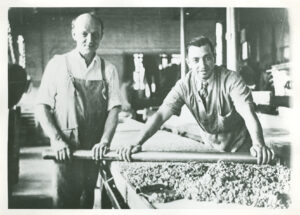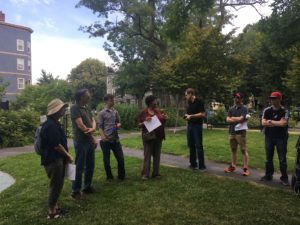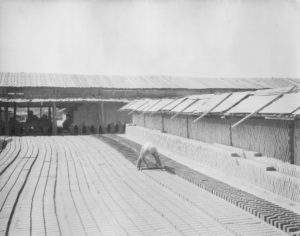Elias Howe, Jr., Inventor Of The Sewing Machine (Part 2)
This article can be found in The Proceedings of the Cambridge Historical Society Volume 14, from the year 1919.
The Victory Over Labor Mobs
Starvation near his door and the $500 of George Fisher exhausted, Howe could now manufacture his machine for sale — if it would sell. To do this, he asked a practical Boston tailor to Cambridge to test it by sewing. All at once the whole company of tailors in Boston rose up against the labor-saving device, crying out, “It will make us beggars by doing away with hand sewing!” For ten years they opposed Howe fiercely.
Howe would not be intimidated. He did not flinch. He would test the sewing machine before the world. He arranged to have a two weeks’ daily demonstration by himself at Quincy Hall Clothing Factory, sewing 250 stitches a minute and beating five of the fastest seamstresses, each doing a seam while he did five of the equal length, faster, neater and stronger. But as a result of violent opposition and the cost of the machine to manufacture, not a machine was ordered!

In the spring of 1846, starvation again stared him in the face, and frail and worn, he tried his hand as engineer at the throttle of a locomotive. But health failed him and he broke under the strain. He tried desperately to sell the model. To testify to this, an original eyewitness is at hand. It is Luther Stephenson of Hingham Center. His letter reads:
Hingham Center, Mass.
Oct. 7, 1910.
Chairman of the Board of Selectmen,
Spencer, Mass. Dear Sir:
About the year 1846, I was employed in the store of Stephenson, Howard and Davis at No. 72 Water Street, Boston, the head of the firm being my father. I remember one afternoon Mr. Howe came to the store, bringing a model of his sewing machine for the inspection of the firm with the view of enlisting them in the manufacture of the same. The model was smaller than the machine now in use and was operated by a crank instead of a treadle as at the present time. This machine Mr. Howe brought as his own invention, and as original with him.
No arrangement was made with him by the firm for manufacturing the machine for business reasons.
Yours truly,
LUTHER STEPHENSON
Yet in his effort to introduce his machine, in his fight with the blindness of labor agitators, Howe won where other would-be inventors of the sewing machine failed because of exactly this same blind opposition to labor-saving machinery. This crushed Thomas Saint upon the eve of his success in England in 1790. This crushed Thimonnier of St. Etienne, France, upon the eve of his discovery in 1830.
In 1790, Thomas Saint patented a machine for sewing leather with a threaded awl with a hole in the point. A mob of glove makers, blindly enraged against this labor-saving machine, scrapped and smashed it.
Thimonnier in 1830 made eighty machines for stitching gloves, a sewing machine all but the feed. Thimonnier’s needle, hooked at the end, descended through the cloth. It brought up the loop through a previously made loop and formed a chain in the upper surface of the fabric. A furious mob attacked his machines just as the government gave him war orders for his eighty models. Thimonnier they nearly murdered. In 1845 he patented it. He tried again in 1848, but the Revolution wrecked his plans. In 1851 he tried in London before the exposition. No notice was taken of his machine and he went home to France to die in the poorhouse in 1857.
In 1832, Walter Hunt in New York, in an alley in Abingdon Square, worked to invent a sewing machine and hit upon the shuttle to form the stitch. But it would not sew, and discouraged, he threw it into the rubbish heap in a garret on Gold Street.
What was it in Elias Howe that would not allow him to be crushed like Saint, Thimonnier and Hunt? It was Spencer’s New England fighting blood and individual worth ingrained after generations from the blood of the sires. His was a victory over a phase of labor agitation that sought to own the laborer and kill the invention of his brain.
Howe met this crisis. All the hoots of labor mobs in the world could not floor him. He did not quail. He owned himself. They could not own him. Labor’s contention today is, the laborer must own himself. It is not only capital that endangers self-ownership. There are kinds of labor agitation that would deny the mechanic’s owning himself. And whenever this happens, labor just as much as capital should not be feared but conquered — and Howe conquered. Challenged at this crisis of labor, son of Spencer, he owned himself. Had he not, as with the others, he would have failed to invent the sewing machine.
Many also derided the invention as a folly. They never thought it would sew. This one thing prevented mob violence by the tailors against Howe. We all know Langley’s airplane models of 1896,1898, and 1903 lay in a Washington museum. They never flew because Langley was crushed by people laughing at him. Yet Glenn Curtis with some changes flew them over Washington.
Elias Howe’s manhood was such that to none of these three things did he yield — mob violence, hardship or laughter. This stands as his greatest tribute, for it marks the man as well as the inventor.
The Battle With Capital And Infringement
In the midst of these rebuffs of fortune, Howe for four months buried himself again at work in Fisher’s attic in Cambridge, and he made another machine. It was a model design, which he carried to Washington, where September 10, 1846, seventy-three years ago, it was approved and patented. But Washington people, when he exhibited it at a great fair, laughed at it as only a mechanical toy.
Fisher had now spent $2000, and declares, “I had lost all confidence in the machine’s paying anything.” With nowhere else to go but the curb, Elias went back to his father’s house with his family. In October he induced his father to send Amasa Howe across the Atlantic to England.
William Thomas of Cheapside was a somewhat chesty manufacturer employing 500 persons at making corsets, umbrellas, valises, shoes, etc. Amasa Howe offered him the machine. It did not take him long to decide. Thomas saw it was the crude beginning of a vast enterprise. For 250 pounds, $1250, Amasa guilelessly sold him the machine and the right to use all he wanted and to patent it in England, paying three pounds royalty. He never paid at all. Thomas made a million dollars by 1867, for he had induced Amasa to beguile Elias across the sea in order to adapt the machine to corsets. February 5, 1847, Elias, pressed financially, sailed for England, to be joined by his wife and three children, whose passage Thomas paid.
As we behold the flying arm of steel in the sewing machine, we can never forget that, carbonized into it, is not only the genius of the inventor, but the sacrifice of a suffering woman — Howe’s loyal wife. In eight months, at only ten dollars a week, Howe made the adaptation of this machine to corsets. At this point, having got out of him all he wanted, Thomas degraded Howe to petty repairs — the beginning of the end. At this snubbing by the English snob, the American of Spencer forebears arose hot in Howe’s veins and he said, “I am poor, but will not kneel to one who treads your soil.”
The selling of an inventor’s brain to capital which alone can thenceforth own the rights is a pawning of the laborer — wrong then and wrong now. I mean by this, the signing over forever of the invention the laborer may make. It keeps him from owning himself and his brain. But the injustice of the capitalist could not crush Howe any more than the injustice of labor. He kowtowed neither to the mob nor the snob.
Comes now another piece of human clay who had a spark in the clod, Charles Inglis, a coach maker. As in George Fisher, Howe in him found human kindness. With his family in three small rooms furnished by Inglis, he proceeded to construct his fourth machine. He was driven to the wall again. Then, forced by starvation and creditors to move into one little room in the cheapest quarters of Surrey, he decided to embark his wife and children for America. There were three children, two daughters and one son.
Inglis recalled: “Before his wife left London he had frequently borrowed money from me in sums of five pounds and requested me to get him credit for provisions. On the evening of Mrs. Howe’s departure, the night was very wet and stormy and, her health being delicate, she was unable to walk. He had no money to pay the cab hire and he borrowed a few shillings from me to pay it, which he repaid by pledging some of his clothing. Some linen came home from his washerwoman for his wife and children on the day of her departure. She could not take it with her on account of not having money to pay this woman. Unable to get a wagon, Howe got a wheelbarrow to carry her trunks to the boat.”
The acid of poverty ate in even more keenly after this. “He borrowed a shilling from me for the purpose of buying beans which I saw him cook and eat in his own room,” added Inglis.
In four months more of the biting ignominy, Howe completed the machine, valued at $250. He could only get $25 for it in a note discounted at $20. Early in April, 1849, without enough to get home, he pawned the model of his first machine and the patent itself. Pushing his handcart of effects to the boat, he sought a job as cook in the steerage for emigrants. So he returned. Landing here four years after his first machine was made, he had but fifty cents in his pocket as reward. Hardly had he rented a cheap immigrant tenement, before he received the tidings that his wife, as a result of her faithful sufferings by his side in his struggle, was dying of consumption in Cambridge. With no means to get there, he waited for ten dollars from his father before he could reach her. He had to borrow a suit of clothes for the funeral. Downcast, bent, but not broken, he went home from the funeral to learn that the ship containing all his tools and effects had been wrecked at Cape Cod!
All was wrecked — but himself and his unconquerable soul.
Thus reduced in America as in England it would seem as if capital had crushed him as well as labor. In his absence, notwithstanding his original model and the elemental devices he had patented, manufacturing machinists were copying his machines everywhere. With it as a basis, inventors were making machines with their own designs added, but all using at least his chief original device — the needle with the eye in the end.
How could he contest? His model was three thousand miles away in a Surrey pawn shop. Hon. Anson Burlingame, however, acting as his representative, with a hundred dollars Howe raised, redeemed his precious model from “the three balls” in the neighborhood of England’s hell of London paupers.
At home, however, four leading manufacturers were infringing upon his patent.
Elias Howe’s father, who had loyally sheltered his boy again and again, sprang to his aid. He mortgaged his old Spencer farm in order to have funds to win the fight. George Bliss took Fisher’s one half share and advanced the money for the patent war. Rufus Choate was Howe’s famous attorney. He began the patent cases in United States courts that in time involved over 30,000 pages. Choate was to win.
In 1850, in New York, Elias Howe was constructing fourteen machines at a little one-horse Gold Street shop, the very street where Hunt had cast discarded his model of a sewing machine. In time, Isaac Merritt Singer, an actor and theatre manager in New York, saw Howe’s machine. At work on a carving machine himself, he took it to Boston and while there repaired a number of sewing machines on which he made, as he declared, three devices as improvements. He at once began commercializing the machines and advertising. He invented, not the machine, but the sewing machine agent. This proved him the greatest commercial organizer for the sale of machines in the world. He did much to domesticate the machine and bring down its price. Yet he was not the inventor, and suddenly Elias Howe accused him of infringing upon his patent, No. 5346. Singer contested it. Unable to prove an original model from England, France and China, he sought an earlier invention to at least supersede Howe’s. He at last landed upon Hunt’s machine of 1832 lying in a garret. He found Hunt, too, but Hunt could not make it run.
Everywhere Howe’s patent held, in the uniform finding of the courts. In 1854 Judge Sprague of the Massachusetts Supreme Court decided “the plaintiff’s patent valid and the defendant’s machine an infringement.” The court concluded, “There is no evidence in this case that leaves a shadow of doubt that for all the benefits conferred upon the public by the introduction of a sewing machine, the public are indebted to Elias Howe.”
This is not saying that in 1849 and 1859, Allen B. Wilson did not construct a four-motion feed for a machine with an original device, later combined with Mr. Wheeler’s rotating hook and shuttle and four-motion feed, the “Wheeler & Wilson” machine. And it is not saying that Gibbs, a Virginian farmer, did not make a great invention — a machine with a revolving hook, later the “Wilcox & Gibbs.” Still other firms made improvements. Over one thousand improvements have been invented.
Yet the original device stood. Howe’s claim was in brief: “I claim the use of an eye pointed needle, operating in connection with a shuttle looper, loop holder, or any other device by which one thread is passed through the loop of another and a stitch is thereby secured.” As to his claims, the U. S. legal conclusion awarded him “vital points far-reaching — the foundation of the whole vast machine structure for sixty years.”
The sewing machine battle ended with the other great firms paying a royalty to Howe of so much a machine. Then in 1856 they combined into a joint stock company or combination to prevent further losses by lawsuits and destructive legal battles. By 1860, just before the Civil War, fifteen years after Howe’s first model which he could not get one order for, there were made 116,330 machines. By 1866, there were 750,000. By 1867 the country was making a thousand machines a day. Four thousand dollars a day was passing into Howe’s hands in royalties when the Civil War broke.
Beyond all financial gain, Elias Howe had made incomputable gifts to his country. In creating domestic industry and in the emancipation of woman, the sewing machine transferred labor from sewing in homes to the factory system. It founded the shoe industry. It gave millions of women work. It emancipated millions of others from painful stitching.
It is not linen you’re wearing out
But human creatures’ lives.
Hood thus sang, and when we count the stitches in one shirt we see it is so. For in each shirt there are over 20,000 stitches.
The Civil War And The Supreme Sacrifice
Happily the touch of comedy had come into the tragedy. With undreamed-of wealth from royalties, Howe remarried. His wife was an English woman he had met in his travels — one perhaps who was a friend in need in bitter days. He established an estate at Bridgeport, next to P. T. Barnum’s estate, and the two were neighbors and friends. Children that romped about this estate have been present at the 1919 centennial and record this phase of his life as a return on his part to the sunniness of his boyhood — a disposition from which he was never embittered and to which therefore he could return along the line of least resistance. There comes down to us today a gold tea-set bought at this time by Elias Howe and given to his father at his golden wedding. His picture at this stage with the fashionable mustachios and loud waistcoat of English pattern reveals a touch of the comedy and interlude in the tragedy — a bit of playtime in the afterglow. Unfortunately, in this picture, however, the interesting marks of struggle were creamed over with fuller face and figure. At this, for a moment, one fails to rejoice, for he misses the illumination born of struggle; for the great text is true — “Ye shall be illuminated — after a great fight of afflictions.” An hour of re-illumination was now however to come, and “a great fight of afflictions.”
It was the crisis of the Civil War.
Isaac Merrit Singer was said to be astonishing New York and London with his equipages and luxuries costing millions of dollars. Why should not Howe? War profits could be enormous. So far as doing for his country, did not his machines by rapid equipment put a million men in the field? Millions of further equipment had to be sewed — underclothes, blankets, overcoats, shoes, knapsacks, haversacks, cartridge belts, tents, balloons, harness, sails, bunting, hammocks. Was not inventing means to equip a million men with these millions of articles enough? The output of that machine reached, as we have seen, many millions of value by 1863, and 52,219 machines were used in war work alone. Sewing machines made even forts, for they made hundreds of thousands of bags to be filled with sand for their parapets. “One day,” declared Parton, “during the war, at three o’clock in the afternoon an order from the War Department reached New York, by telegraph, for fifty thousand sandbags such as are needed in field works. By two o’clock the next afternoon the bags had been made and packed and shipped and started southward.” In all, nineteen million dollars were saved to the country by the machines.
Was it not enough? Should Howe not have a good time like Singer, on his $4000 a day, and “play around” on his estate next P. T. Barnum’s? But it was not enough for Howe. He had sacrificed his home, wife, health, sleep and food during sixteen years of suffering. Yet fourteen Bemises had been in the Revolution, eight in the Federal Army. The blood of his patriot fathers would not let him sit at ease, be a profiteer, and spend his $4000 a day. Clara Barton’s “What is money without a country?” was also his grand protestation. He would give all on the altar.
He could have been exempted, not only for age and on account of producing equipment, but because of his tendency to lameness. All of his life he hid it. Concealing it again, he enlisted as a private in the Seventh Regiment Infantry, Co. D, and was not to be mustered out till July, 1865. All through life’s crushing pain, he never had complained. Why now? In an original letter to me from Jane R. Caldwell, once the little daughter, she says, ” I have never heard him complain in all the tribulations of his sad home. Regarding my father’s lameness, though it might have troubled him at times, I never heard him complain of it and doubt that except in the event of a long march he was disqualified as a soldier. He was a man of peace, but his patriotism was great and he was willing to serve his country to the extent of his ability.”
He therefore gave his own body as a humble private. He did this though he raised and equipped the regiment. Though walking himself, he presented every officer a horse. When the company had not been paid for months, Howe stopped out of the disappointed files and asked the subordinate, “What is the back pay? When is it ready?” “When the Government is ready and not before,” snapped the petty paymaster. “How much is due them?” “Thirty-one thousand dollars.” Howe amazed the petty officer by seizing a pen and writing a check for the whole. Then he stepped up at his own time in the file of “buck” privates and received his back pay — $28.60.
Officially, he came out with no more honor than when he went in. Really, he came out with the greatest honor mankind can bestow — the record of a Christ-like self-bestowal and death for the cause. For in 1867, though twice a millionaire, as a victim of his terrific exertion, he died of Bright’s disease in Brooklyn, N. Y.
Two years after his death, in 1869, at an International Exposition, great-souled France, though its Thimonnier failed at the point of success, at the hand of Emperor Louis, accorded Howe France’s highest honor, the Cross of the Legion of Honor. At the fourth election, America, through the Committee of National Judges, elected Howe to the Hall of Fame, together with Daniel Boone and five others, the list ending with Rufus Choate, his patent attorney, who won his great cases on the patent which mark the triumph which we celebrate today — the triumph of the sewing machine.
1 Mrs. Austin C. Wellington (Sarah Cordelia Fisher).




